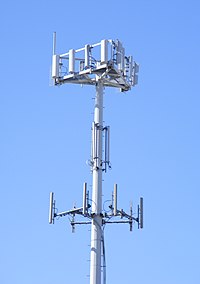
Cell site

A cell site, cell tower, or cellular base station is a cellular-enabled mobile device site where antennae and electronic communications equipment are placed—typically on a radio mast, tower, or other raised structure—to create a cell (or adjacent cells) in a cellular network. The raised structure typically supports antenna and one or more sets of transmitter/receivers transceivers, digital signal processors, control electronics, a GPS receiver for timing (for CDMA2000/IS-95 or GSM systems), primary and backup electrical power sources, and sheltering. In Global System for Mobile Communications (GSM) networks, the correct term is Base Transceiver Station (BTS), and colloquial synonyms are 'mobile phone mast' or 'base station'. Multiple cellular providers often save money by mounting their antennas on a common shared mast; since separate systems use different frequencies, antennas can be located close together without interfering with each other. Some provider companies operate multiple cellular networks and similarly use colocated base stations for two or more cellular networks, (CDMA2000 or GSM, for example). Some cities require that cell sites be inconspicuous; they can be blended with the surrounding area or mounted on buildings or advertising towers. Preserved treescapes can often hide cell towers inside an artificial or preserved tree. These installations are generally referred to as concealed cell sites or stealth cell sites. A cellular network is a network of handheld mobile phones (cell phones) in which each phone communicates with the telephone network by radio waves through a local antenna at a cellular base station (cell site). The coverage area in which service is provided is divided into a mosaic of small geographical areas called 'cells', each served by a separate low power multichannel transceiver and antenna at a base station. All the cell phones within a cell communicate with the system through that cell's antenna, on separate frequency channels assigned by the base station from a common pool of frequencies used by the system. The purpose of cellular organization is to conserve radio bandwidth by frequency reuse; the low power radio signals used within each cell do not travel far beyond the cell, so the radio channels can be reused in geographically separated cells. When a mobile user moves from one cell to another, his phone is automatically 'handed off' to the new cell's antenna, and assigned a new set of frequencies, and subsequently communicates with this antenna. This background handoff process is transparent to the user and can occur in the middle of a phone call without any service interruption. Each cell phone has an automated full duplex digital transceiver and communicates with the cell antenna over two digital radio channels in the UHF or microwave band, one for each direction of the bidirectional conversation, plus a control channel which handles registering the phone with the network, dialing, and the handoff process. Typically a cell tower is located at the edge of one or more cells and covers multiple cells using directional antennas. A common geometry is to locate the cell site at the intersection of three adjacent cells, with three antennas at 120° angles each covering one cell. The type of antenna used for cellular base stations (vertical white rectangles in pictures), called a sector antenna, usually consists of a vertical collinear array of dipoles. It has a flat fan-shaped radiation pattern, which is tilted slightly down to cover the cell area without radiating at higher angles into further off cells which reuse the same frequencies. The elevation angle of the antenna must be carefully adjusted, so the beam covers the entire cell without radiating too far. In modern sector antennas beam tilt can usually be adjusted electronically, to avoid the necessity of a lineman climbing the tower to mechanically tilt the antenna when adjustment is needed.
